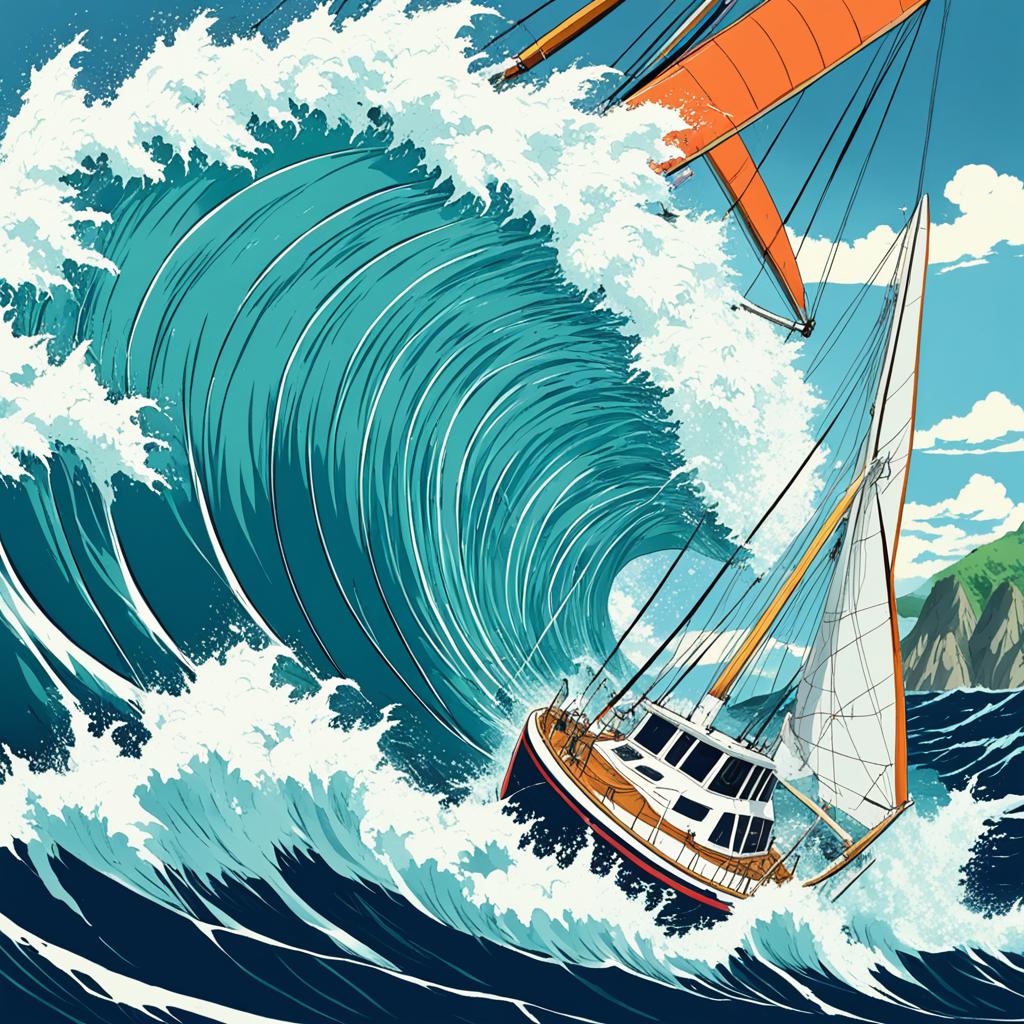Embarking on a Pacific crossing from California to Hawaii is a thrilling sailing adventure that captivates the minds of many sailors. But is it truly safe to undertake this daring journey? Let’s explore the risks, challenges, and precautions involved in sailing from California to Hawaii to help you determine if you’re prepared for this epic voyage.
The Pacific crossing from California to Hawaii spans approximately 2,400 miles, and depending on various factors, it can take anywhere from 12 to 20 days. While the allure of the open seas beckons, it’s vital to understand the hazards that await along the route.
Storms, equipment failures, coral reefs, shipping lanes, and encounters with marine wildlife are just a few of the challenges that sailors may face on this journey. To ensure safety, sailors must be equipped with a well-maintained boat, suitable safety equipment, and a solid understanding of weather conditions.
So, is it safe to sail from California to Hawaii? Join us as we delve into the details, debunk common beliefs, and provide the essential tips and precautions for a successful and secure sailing experience across the vast Pacific Ocean.
The Distance Between California and Hawaii

Sailing from California to Hawaii covers a distance of approximately 2,400 miles, making it a challenging yet exhilarating direct sailing trip. The journey typically takes between 12 to 20 days, depending on factors such as the speed of your boat and prevailing weather conditions.
When planning your route, it’s essential to consider the Pacific High, a semi-permanent high-pressure system in the North Pacific Ocean. The Pacific High plays a crucial role in determining the best route for your voyage. Many sailors aim to stay on the southern edge of the Pacific High to take advantage of the trade winds, which can provide additional propulsion towards Hawaii.
Traveling this distance requires careful planning, navigation, and an understanding of prevailing weather conditions. By harnessing the power of the trade winds and strategically navigating the Pacific High, you can make the most of your journey from California to Hawaii.
Hazards Along the Route

Sailing from California to Hawaii is an exhilarating journey, but it is not without its hazards. As you venture into the vastness of the Pacific Ocean, you must be prepared to navigate through and overcome various challenges along the route.
One of the most significant challenges you may face is the possibility of encountering storms and rough seas. The Pacific Ocean is known for its unpredictable weather patterns, with sudden changes in wind direction, heavy rain, and turbulent waves. It is essential to have a well-maintained boat equipped to handle strong winds, heavy rain, and large waves.
To ensure your safety and the safety of your crew, it is crucial to stay informed about the weather conditions and plan your journey accordingly. Monitoring weather forecasts and consulting with experienced sailors can provide valuable insights into potential storm risks and allow you to navigate around them.
Additionally, be mindful of other hazards along the route. Coral reefs pose a threat to your vessel, especially in shallow areas. Careful navigation and understanding the depth charts are vital to avoid running aground or damaging your boat.
Shipping lanes are another hazard to consider. These are the designated routes for commercial vessels, and encountering them can be dangerous due to the large size and speed of cargo ships. Stay vigilant and be prepared to yield the right of way to these vessels to ensure your safety.
As you sail through the open ocean, you will also encounter a diverse range of marine wildlife. While witnessing the beauty of sea creatures can be awe-inspiring, it is essential to maintain a safe distance and avoid disturbing their natural habitat.
Now, take a moment to visualize the hazards sailors face when sailing from California to Hawaii. The image below encapsulates the thrilling adventure and potential risks of this journey.
| Hazards | Precautions |
|---|---|
| Storms and rough seas | – Monitor weather forecasts – Have a well-maintained boat equipped to handle strong winds and waves – Plan your journey to avoid the worst weather conditions |
| Coral reefs | – Study depth charts and navigational aids – Maintain a safe distance from shallow areas – Be cautious when approaching unfamiliar reefs |
| Shipping lanes | – Stay vigilant and monitor AIS systems – Yield the right of way to commercial vessels – Communicate with ships to ensure safe passage |
| Marine wildlife | – Observe marine wildlife from a distance – Avoid actions that could disturb or harm the animals – Educate yourself on local regulations regarding wildlife encounters |
By understanding and preparing for these hazards, you can enhance your safety and make the most of your sailing adventure from California to Hawaii. Stay informed, stay cautious, and enjoy the journey through the mesmerizing Pacific Ocean.
Weather and Sea Conditions

When planning a sailing trip from California to Hawaii, it’s important to consider the weather and sea conditions. The Pacific Ocean can be unpredictable, and sailors must be prepared for various challenges they might encounter along the way.
The most popular time to sail from California to Hawaii is during the summer months (June to September). During these months, the trade winds blow consistently from the northeast, providing favorable sailing conditions. The trade winds can help propel your boat towards Hawaii, making the journey smoother and more enjoyable.
However, even during the summer months, sailors may still encounter strong winds and rough seas. It’s essential to continuously monitor weather forecasts and be prepared for changes in conditions. Keeping an eye on the weather can help you make informed decisions and adjust your sailing strategy accordingly.
The winter months (December to March) bring stronger winds and larger swells, making it more challenging to sail from California to Hawaii. If you’re considering a winter crossing, it’s crucial to have extensive experience and be prepared for these demanding conditions. Proper boat maintenance, additional safety precautions, and advanced sailing skills are necessary to handle the stronger winds and rougher seas.
Storm risks are significant in the Pacific Ocean, with the potential for tropical cyclones and Pacific hurricanes. Close monitoring of weather forecasts is critical to stay ahead of any approaching storms and take appropriate actions to ensure the safety of yourself and your vessel.
Vessel Requirements and Preparations
Before embarking on a sailing trip from California to Hawaii, it’s essential to ensure that your vessel meets specific requirements and is properly equipped for the journey. Safety and seaworthiness should be your top priorities when selecting a boat. Look for a vessel with a strong hull, reliable rigging, a comfortable interior, and ample storage space for provisions and equipment.
In addition to choosing the right boat, it’s crucial to register your vessel and comply with all legal requirements. Proper registration not only ensures regulatory compliance but also assists in search and rescue operations if needed. Don’t overlook the importance of adequate provisioning for a safe and comfortable journey. Make sure to stock up on non-perishable food, fresh water, and sufficient fuel, taking into account the estimated duration of the voyage and potential delays.
Communication and navigation equipment play a vital role in maintaining safety and staying on course during the trip. Ensure that your VHF radios, satellite phones, EPIRBs, GPS, charts, and compasses are all in good working order. Regular maintenance of these devices is essential to ensure their reliability before setting sail. For more information and guidance on vessel requirements, boat selection, registration, provisioning, and equipment, consider consulting reputable sources like USCG Boating and Sail Magazine.
FAQ
Q: Is it safe to sail from California to Hawaii?
A: Sailing from California to Hawaii is a thrilling adventure, but it’s important to understand the risks and challenges involved. Careful preparation, experience, and navigation are key to ensuring a safe and enjoyable journey.
Q: What is the distance between California and Hawaii?
A: The distance between California and Hawaii is approximately 2,400 miles. The journey can take anywhere from 12 to 20 days, depending on the speed of the boat and prevailing weather conditions.
Q: What hazards can be encountered along the route?
A: Hazards along the route include storms, rough seas, unpredictable weather patterns, strong winds, heavy rain, large waves, coral reefs, shipping lanes, and marine wildlife. Sailors must be prepared to navigate through these challenges.
Q: What are the weather and sea conditions like for sailing from California to Hawaii?
A: The most popular time to sail from California to Hawaii is during the summer months (June to September) when the trade winds blow consistently from the northeast, providing favorable sailing conditions. However, even during the summer months, sailors may still encounter strong winds and rough seas. The winter months (December to March) can be more challenging, with stronger winds and larger swells. Storm risks, such as tropical cyclones and Pacific hurricanes, are also significant. Close monitoring of weather forecasts is crucial.
Q: What are the vessel requirements for sailing from California to Hawaii?
A: Before embarking on the journey, it’s essential to ensure that the vessel meets certain requirements and is properly equipped. This includes factors such as a strong hull, reliable rigging, a comfortable interior, sufficient storage space for provisions and equipment, proper registration, compliance with legal requirements, and well-maintained communication and navigation equipment.
